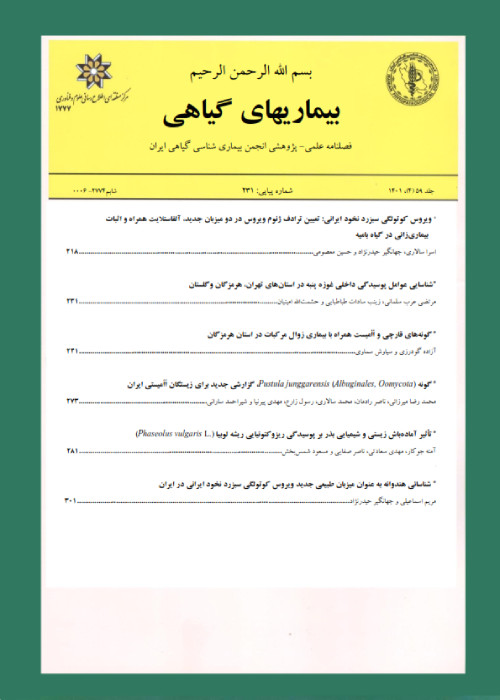ISOLATION OF Enterobacter nimipressuralis ASSOCIATED WITH BACTERIAL WET WOOD FROM ELM (Ulmus SPP.)IN RAFSANJAN
Abstract:
Bacterial wet-wood or bacterial slime is a common disease that affects the central core of many shade and forest trees like ash, fir, maple, oak, sycamore and elm (Scortichini et al., 1991). Symptoms of this disorder include a yellow-brown discoloration of the wood, generally confined to the central core of the tree. This affected wood is wetter than surrounding wood and is under high internal pressure. The gas pressure and high moisture content cause an oozing or bleeding of slime, from pruning cuts, through bark cracks and branch crotches. Several bacteria often are associated with wet-wood. It has not been conclusively demonstrated that these bacteria cause the disease, (Murdoch & Campana, 1983). Some recent references indicated that the bacterium Enterobacter nimipressuralis may be involved in the development of wet-wood (Brenner et al., 2005). There is no incidence of the diseas in Iran. In spring of 2011 a similar disease was observed on elm trees in repont on Rafsanjan, Kerman province. The infected tress showed liquid exuding from wounds including origin, branch stubs or barks cracks, and vertical streaks of white to gray encrustations of dried effluent on bark surfaces. Bark was removed from infected trees and segments of cambium bearing lesions were cut and surface sterilized and teased apart in a few drops of sterile water. After few minutes’ incubation, loopfuls of the suspension were streaked onto plates of NA, KINGs B, YDC and EMB media and incubated at 25oC for 2 days. Some biochemical and physiological characteristics of the isolates that produced metalic green pigment on EMB medium, was determined (Schaad et al., 2001). Strains were gram negative, and positive in tests for MR/VP but negative for oxidase, arginine dhydrolase, hydrolysis of Tween-80, gelatin liquefaction and hypersensitive reaction on tobacco (Nicotiana tabacum). All strains utilized glucose, mannitol, manose, rhamnose, and sorbitol. Arabitol, adonitol, dulcitol, mayo-Inositol and glycerol were not used as carbon source for growth. For further investigation, total DNA was extracted from some isolates using alkaline lysis procedure. A segment of 16s rDNA gene were amplified by PCR using 63f and 1387r as a reverse and forward universal primers, respectively (Marchesi et al., 1998). The amplified fragments (PCR products) were purified using Accu Prep PCR purification Kit (Bionner, South Korea) and were sequenced. Sequencing of the entire 16S rDNA gene of representative elm isolates allowed us to compare their relatedness. Elm isolates clustered in the same clade with E. nimipressuralis. Nucleotide sequence analysis in GenBank showed that the nucleotide sequence of 16s rRNA gene of Elm strains had 99% similarity to reference strains of E. nimipressuralis. Based on our knowledge this is the first report of isolation of E. nimipressuralis associated with bacterial wet-wood from elm trees in Iran. The infected trees were eradicated by municipality organization.
Language:
Persian
Published:
Iranian Journal of Plant Pathology, Volume:47 Issue: 4, 2012
Page:
481
magiran.com/p966810
دانلود و مطالعه متن این مقاله با یکی از روشهای زیر امکان پذیر است:
اشتراک شخصی
با عضویت و پرداخت آنلاین حق اشتراک یکساله به مبلغ 1,390,000ريال میتوانید 70 عنوان مطلب دانلود کنید!
اشتراک سازمانی
به کتابخانه دانشگاه یا محل کار خود پیشنهاد کنید تا اشتراک سازمانی این پایگاه را برای دسترسی نامحدود همه کاربران به متن مطالب تهیه نمایند!
توجه!
- حق عضویت دریافتی صرف حمایت از نشریات عضو و نگهداری، تکمیل و توسعه مگیران میشود.
- پرداخت حق اشتراک و دانلود مقالات اجازه بازنشر آن در سایر رسانههای چاپی و دیجیتال را به کاربر نمیدهد.
In order to view content subscription is required
Personal subscription
Subscribe magiran.com for 70 € euros via PayPal and download 70 articles during a year.
Organization subscription
Please contact us to subscribe your university or library for unlimited access!


